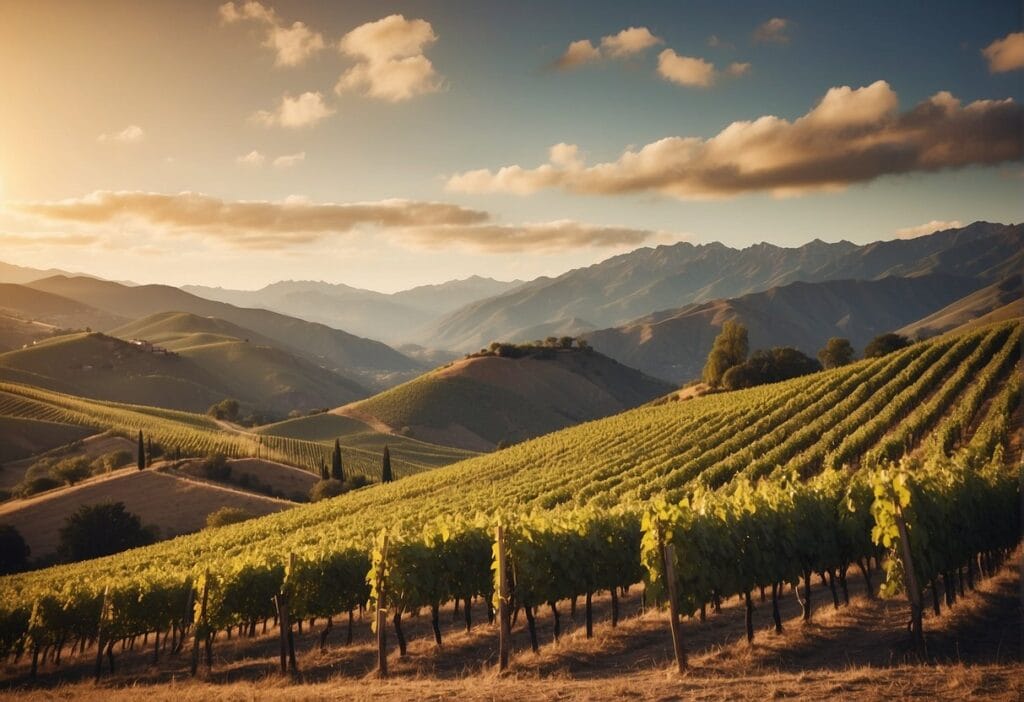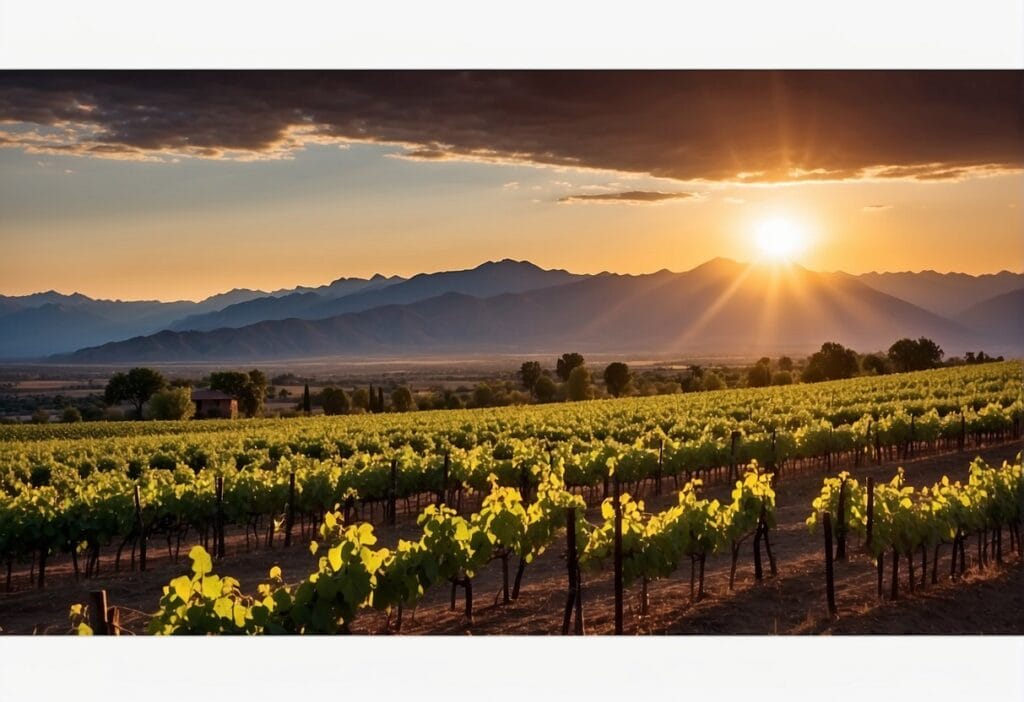Nestled just south of Santiago, the capital of Chile, the Maipo Valley Wine Region is renowned for its exceptional red wines, particularly those crafted from Cabernet Sauvignon. The valley’s proximity to the Andes Mountains and Pacific Ocean creates a microclimate that is optimal for vineyard cultivation.
This unique geographic setup has positioned the Maipo Valley at the forefront of Chile’s wine industry, with a reputation for producing wines that competently stand on the international stage.
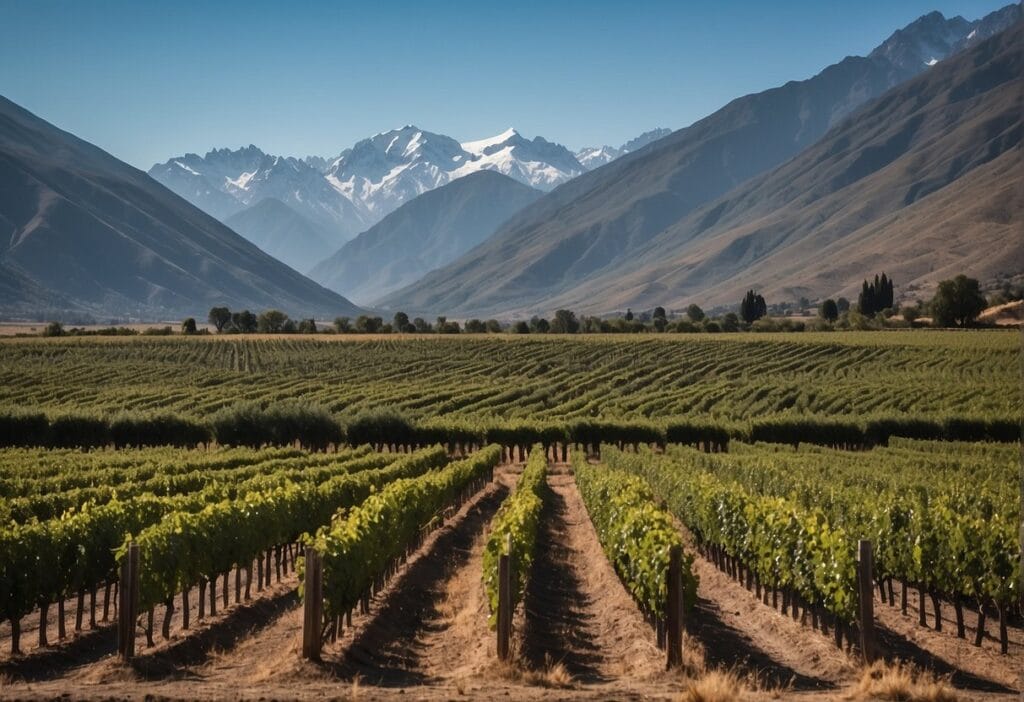
The Maipo Valley’s winemaking tradition dates back hundreds of years, making it not only a center for contemporary viticulture but also a place steeped in rich history. Today, the region is a vibrant reflection of its past, embracing modern winemaking methods while cherishing the legacy left by early Spanish settlers.
For wine enthusiasts and travelers alike, the Maipo Valley offers an array of wine tours and tastings, providing an immersive experience into the world of Chilean red wines. Alongside the exceptional wines, visitors are also drawn to the cultural events and the opportunity to explore outdoor recreation amidst the stunning backdrop of this well-regarded wine region.
Key Takeaways
- The Maipo Valley is celebrated for its premium Cabernet Sauvignon and ideal winegrowing conditions.
- Steeped in history, the Maipo Valley integrates traditional and modern winemaking practices.
- Visitors can enjoy extensive wine tours and cultural events in this scenic region near Santiago.
Geography and Climate
The Maipo Valley wine region boasts an intricate geography influenced by its proximity to both the Andes Mountains and the Pacific Ocean, creating a range of microclimates perfect for viticulture.
Proximity to Santiago and the Andes
The Maipo Valley lies just south of Santiago, nestled against the majestic Andes Mountains. This location provides a stunning backdrop and plays a crucial role in the unique climatic conditions you’ll find in the vineyards. The Andes not only offer a source of meltwater for irrigation but also impact the diurnal temperature variation which is essential for the development of the grapes’ complex flavors.
Climate Variability
In Maipo Valley, climate variability is significant across its subregions. As you move eastwards closer to the Andes, the climate gets cooler, which is ideal for producing wines with more structure and acidity. Conversely, areas closer to the Pacific Ocean experience the cooling influence of the Humboldt Current, which contributes to a more moderate climate with a beneficial effect on the ripeness and health of the grapes.
Soil Types and Terroir
Your understanding of Maipo Valley’s wines isn’t complete without delving into its soil types and terroir. Primarily, the region benefits from rich alluvial soils with good drainage, found along the Maipo River.
These soils are a mix of sand, clay, and gravel that impart distinct qualities to the wines, often enhancing their elegance and minerality. This composition, along with the local climate, influences the terroir and is reflected in the character and flavor profile of the wines produced.
History of Maipo Valley
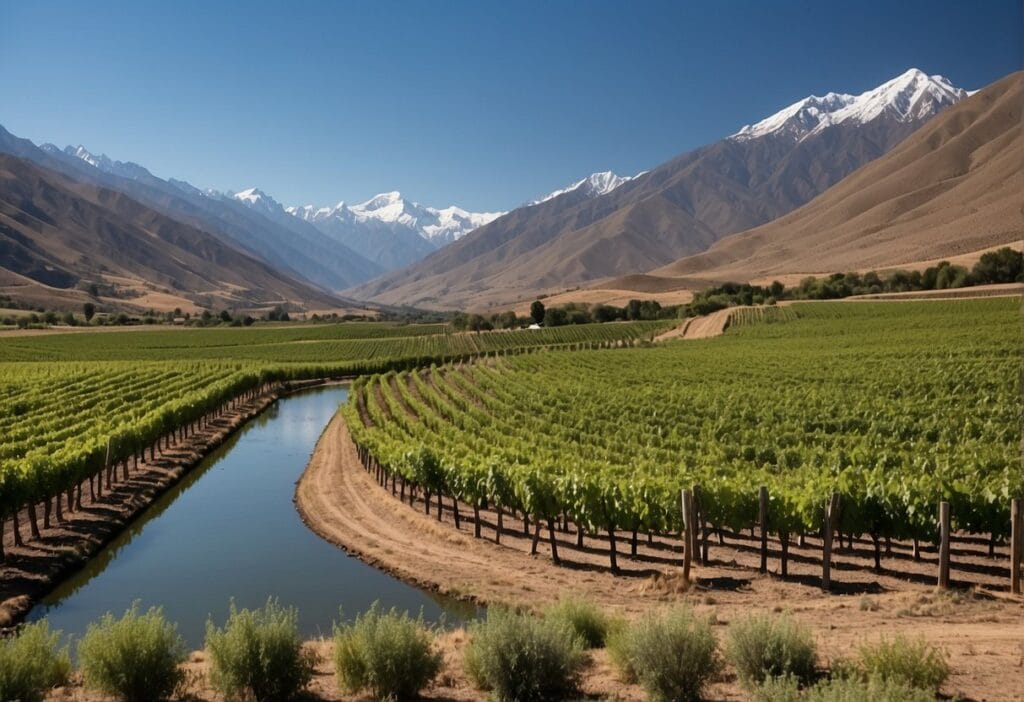
As you explore the rich tapestry of the Maipo Valley, you’ll discover the roots of the Chilean Wine Industry and its ascent to the status of the Bordeaux of South America.
Early Viticulture
The initiation of viticulture in the Maipo Valley marks an important milestone in Chile’s wine history. Vines were first planted around the mid-16th century, coinciding with the time of Santiago’s establishment in the 1540s.
The region’s viticultural foundation was the work of Spanish conquistadors and missionaries who brought European vines to Chilean soil. This infusion of a wine culture laid the groundwork for what would become a flourishing wine industry that spans centuries.
Global Recognition
Over the years, the Maipo Valley garnered global recognition for its premium wines, particularly reds that compare favorably with renowned Bordeaux wines. By combining old-world expertise with unique terroir, Maipo Valley earned its moniker as the Bordeaux of South America.
The valley’s proximity to the capital, Santiago, has also played a role in its prominence, offering ideal conditions for growing high-quality grapes that produce some of the country’s most celebrated wines.
Winemaking in Maipo Valley
In the heart of Chile, the Maipo Valley stands out as a premier destination for high-quality wines. You’ll find a focus on noble grape varieties and traditional winemaking techniques that are adeptly matched with modern innovation.
Grape Varieties
The Maipo Valley primarily excels in producing full-bodied red wines, with Cabernet Sauvignon leading the charge as the most planted and celebrated variety. Your palate can also savor the rich and diverse flavors of other notable reds such as Merlot, Syrah, and Carménère, a grape that has become synonymous with Chilean identity.
Beyond reds, Maipo Valley offers refreshing white wines including Chardonnay and Sauvignon Blanc, catering to your taste for crisp and aromatic white-wine varieties.
Winemaking Techniques
Winemakers in Maipo Valley employ both time-honored and innovative techniques to craft their wines. Traditional methods meet technological advancements, ensuring each wine expresses the unique terroir of this region. With a focus on quality over quantity, vintners here often adhere to hand-harvesting grapes to preserve their purest expression for your wine tasting experience.
Aging and Oak Barrels
Oak barrels play a pivotal role in the winemaking process, imparting complex flavors and contributing to the graceful aging of the wine. Maipo Valley producers often use both American and French oak barrels to age their wines, adding layers of subtlety and finesse. This practice is most evident in their red wines, especially Cabernet Sauvignon, which gains richness and depth from this time-honored aging process.
Wine Tours and Tastings
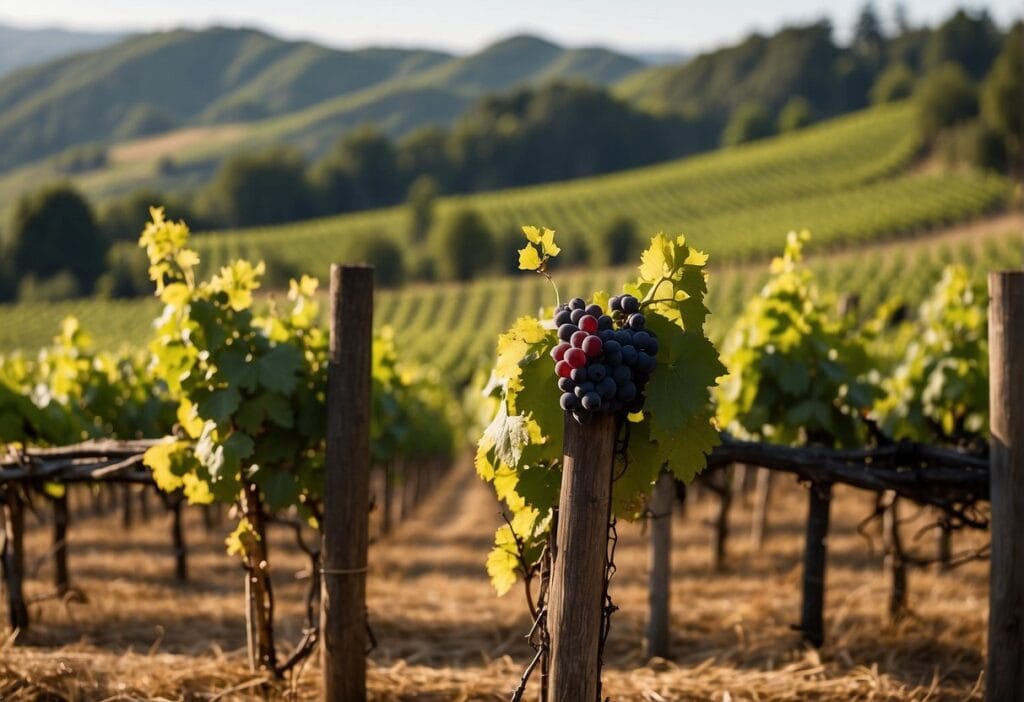
Discovering the Maipo Valley through its wine tours and tastings is a delightful way to experience the region’s renowned vineyards and wines. Whether you prefer to explore with a guide or at your own pace, there’s an option tailored for your taste.
Guided Tours
Guided tours offer a comprehensive experience, often including hotel pickup and transportation. You can book a Wine Tasting Tour where experts will walk you through the vineyards, explaining the winemaking process and introducing you to the estate’s selections. Guided options rule out the need for a designated driver, ensuring a safe and enjoyable day trip.
- Little Wine Bus: A popular choice, this full-day tour combines wine with whimsy.
- Bus Tours: Let others handle the navigation while you enjoy a guided tasting experience.
Self-Guided Options
If you prefer to explore at your own pace, self-guided tours can be a flexible alternative. You may consider a car rental to journey through the valley, giving you the freedom to visit the wineries on your list.
- Biking: An eco-friendly way to see the vineyards. Remember safety—helmets on!
- Map and Information: Get a map from local tourism offices to help navigate your tour.
Wine and Culinary Experiences
The Maipo Valley’s wine and culinary experiences are a gourmand’s dream. Pair your tastings with exquisite local cuisine. Live the wine culture by participating in activities that blend gastronomy with vineyard visits.
- Private Bike Wine Tour: Cycle through scenic routes and enjoy a paired meal.
- Horseback Wine Tour and a Country Grill: Combine adventure with a rustic dining experience.
Choose the tour that suits your style and prepare for an unforgettable journey through the Maipo Valley’s storied winelands.
Prominent Wineries
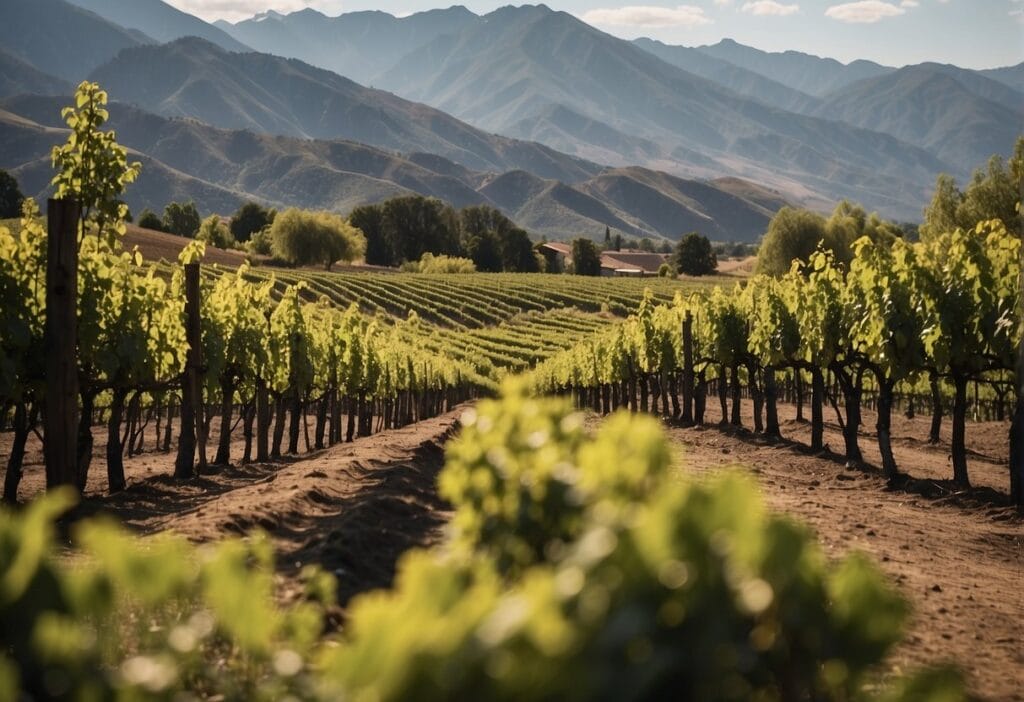
When exploring Maipo Valley, you’ll find a diverse range of wineries spread across three distinct areas: Alto Maipo, Central Maipo, and Lower Maipo. Each region has its own character, influenced by unique terroirs and a legacy of wine-making traditions.
Alto Maipo Wineries
Alto Maipo is renowned for its premium red wines, reminiscent of Bordeaux but with a Chilean twist. The area of Puente Alto is particularly esteemed, home to Almaviva, a winery resulting from the collaboration between Viña Concha y Toro and Baron Philippe de Rothschild. Don Melchor, another illustrious winery located here, is celebrated for its elegant and complex Cabernet Sauvignon.
- Almaviva: A partnership blending Chilean and French winemaking expertise, featuring exceptional Cabernet Sauvignon.
- Don Melchor: A world-class winery with a focus on crafting sophisticated Cabernet Sauvignon.
Central Maipo Wineries
Venture into Central Maipo, where wineries like Undurraga and De Martino stand out with their innovative winemaking methods demonstrating the versatility of the region. Located in the subregions of Pirque and Buin, they deliver a variety of high-quality wines that reflect the central heart of Maipo Valley.
- Undurraga: Known for exploring unique varietals and methods, contributing to the rich variety of Central Maipo wines.
- De Martino: Pioneering with wines that express the identity of their origin, especially in sustainable practices.
Lower Maipo Wineries
Finally, the Lower Maipo – made up of areas such as Paine, Isla de Maipo, and Talagante – hosts wineries that wonderfully balance tradition with modernity. Santa Rita is a key player in this region, offering a broad range of wines that have garnered international acclaim.
- Santa Rita: A prestigious winery with a broad portfolio that has earned a place in the global wine scene.
Cultural and Recreational Activities
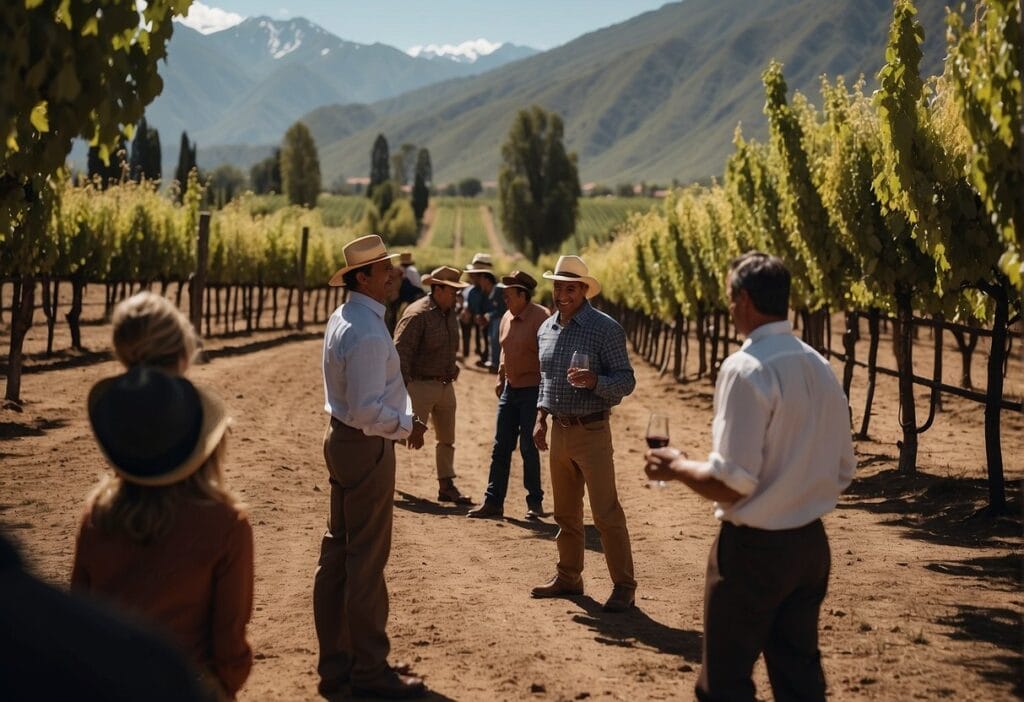
The Maipo Valley offers an array of cultural and recreational activities that cater to outdoor enthusiasts and wine lovers alike. Here, you’ll find picturesque trails for hiking and walking, alongside opportunities to immerse yourself in the local festivities that celebrate the region’s rich viticultural heritage.
Outdoor Adventures
Hiking: Lace up your hiking boots and explore the captivating landscapes of Maipo Valley. A popular trail leading up to Cerro Manquehuito promises breathtaking views. You’ll encounter a variety of flora, with the scenic backdrop of the Andes adding to the experience.
Walking: If you prefer a leisurely pace, take a walking tour through the vineyards. As you wander, enjoy the stunning vistas of the rolling hills, each step offering a unique perspective of this renowned wine region.
Local Festivities
Celebrate with the locals at wine festivals, where you’ll savor exquisite local vintages and learn directly from the winemakers. These events often host live music and dance, allowing you to soak in the vibrant culture while you indulge in the region’s finest wines.
Sustainable Practices and Innovations
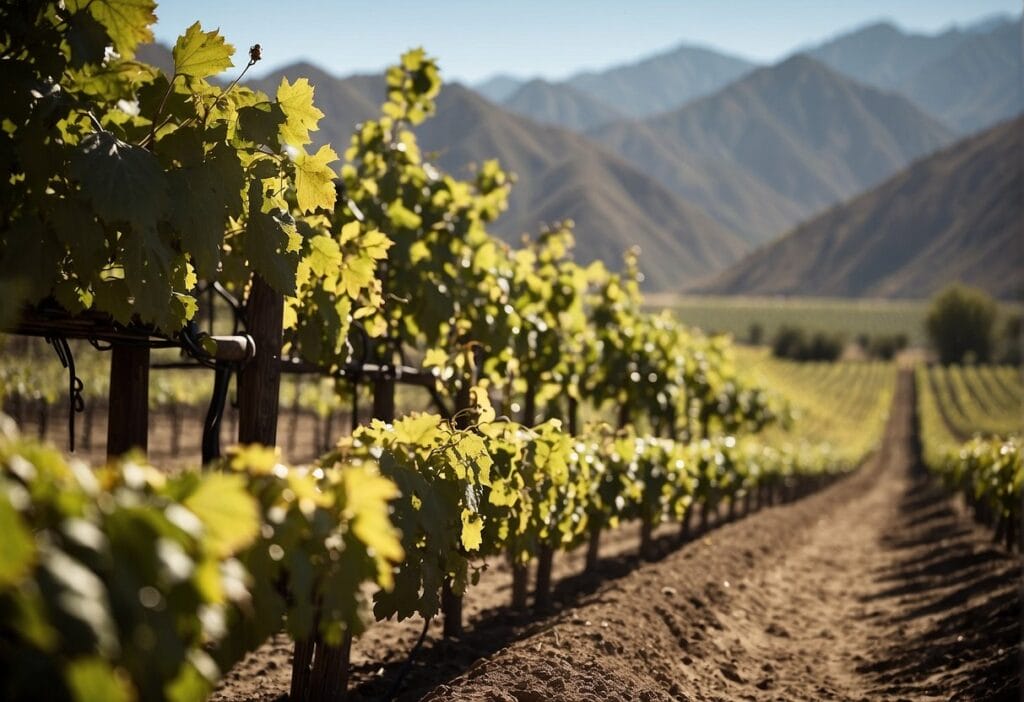
In the Maipo Valley wine region, winemakers have adopted forward-thinking methods to preserve the environment and enhance the quality of their wine. Water conservation and organic farming are at the forefront of these efforts.
Water Conservation
Your appreciation for Maipo Valley wines grows deeper when you learn about the water saving techniques like drip irrigation. This system allows for precise water delivery directly to the roots of the vines, minimizing waste and maximizing efficiency. Understand that this method not only conserves precious water resources but also creates a healthier environment for vine growth.
Organic Farming
Organic farming is becoming a hallmark of the Maipo Valley, as you’ll find many wineries embracing these methods. Winemakers here are turning their backs on synthetic pesticides and fertilizers, opting instead for natural alternatives that foster biodiversity. By doing so, they ensure that every bottle you enjoy is a product of sustainable practices that keep both your health and the earth’s well-being in mind.
Sub-Regions and Their Characteristics
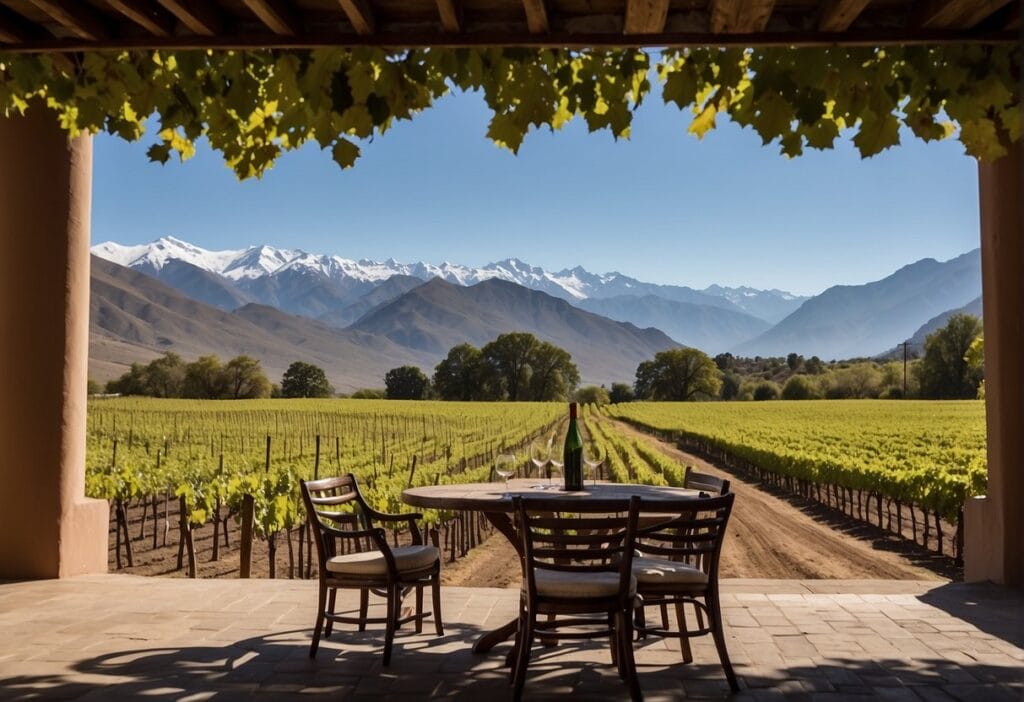
Maipo Valley is not a monolith; each sub-region offers a unique profile and terroir, contributing to the complex tapestry of wine this region is celebrated for. Let’s explore what makes each of them stand out.
Alto Maipo Distinction
In the Alto Maipo, you’ll find vineyards stretching along the foothills of the Andes, benefiting from the cooler temperatures at higher altitudes. This area is renowned for its Cabernet Sauvignon with exceptional structure and natural acidity. The Upper Maipo in particular is recognized for wines with a perfect balance of ripeness and freshness, often compared to prestigious Old-World names.
Coastal Influences
Pacific Maipo, sitting closer to the chilly breezes of the Pacific Ocean, leverages the Coastal Range’s influence to produce wines of pronounced freshness. This microclimate is especially conducive for Carmenere, a varietal that thrives on the natural acidity provided by these coastal conditions, giving it a distinctive character compared to those from warmer areas like Mendoza.
Varietal Differences
Each sub-region within Maipo brings its unique twist to the varietals grown. While Central Maipo is often associated with well-structured Cabernet blends, the diverse soils and slight climatic variations across the valley, including areas like Maipo Medio and Maipo Bajo, contribute to a rich palette of flavors and aromas. The craftsmanship behind these blends is evident, transforming Maipo Valley into a vigorous competitor on the world wine stage.
Frequently Asked Questions
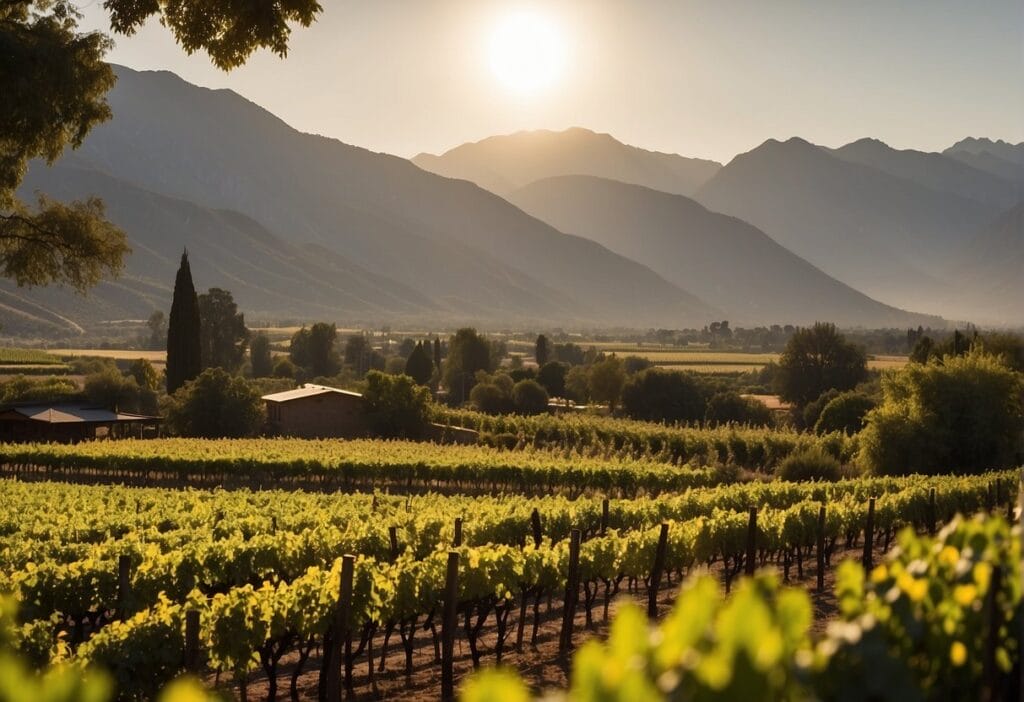
This section offers insights into what wines Maipo Valley is renowned for, activities to enjoy, towns to explore, planning wine tours, accommodations, and the region’s standing among Chilean wine regions.
What wine is Maipo Valley best known for?
Maipo Valley excels in producing Cabernet Sauvignon, with rich flavors that have garnered global recognition. The region’s winemaking reflects a long-standing heritage, giving life to wines with depth and character.
Can you recommend some top activities to do when visiting the Maipo Valley?
When you visit Maipo Valley, besides tasting exquisite wines, immerse yourself in local culture with open cellar door experiences, explore cultural and natural sites, and savor the local gastronomy. Adventure enthusiasts can also enjoy hiking in the nearby Andes Mountains.
What are the most prominent towns to visit in Maipo Valley?
In Maipo Valley, don’t miss the charming towns of Pirque and Puente Alto. These towns are stepping stones to numerous vineyards and offer a slice of local life amidst the backdrop of the Andes.
How do I plan a wine tour in the Maipo Valley?
To plan your wine tour, consider booking a small group tour that includes visits to several wineries throughout the day. This way, you can learn about the winemaking process and sample various wines without the worry of transportation.
What are some recommended accommodations in Maipo Valley?
For a comfortable stay, you might find boutique guesthouses and lodges nestled among the vineyards, providing a tranquil retreat. Alternatively, there are various accommodation options a short drive away in Santiago.
Is Maipo Valley considered the best wine region in Chile?
While “best” can be subjective, Maipo Valley is often compared to the prestigious Bordeaux region, earning it the moniker of the ‘Bordeaux of South America’. Its reputation is especially strong for red wines, with Cabernet Sauvignon leading the way.
